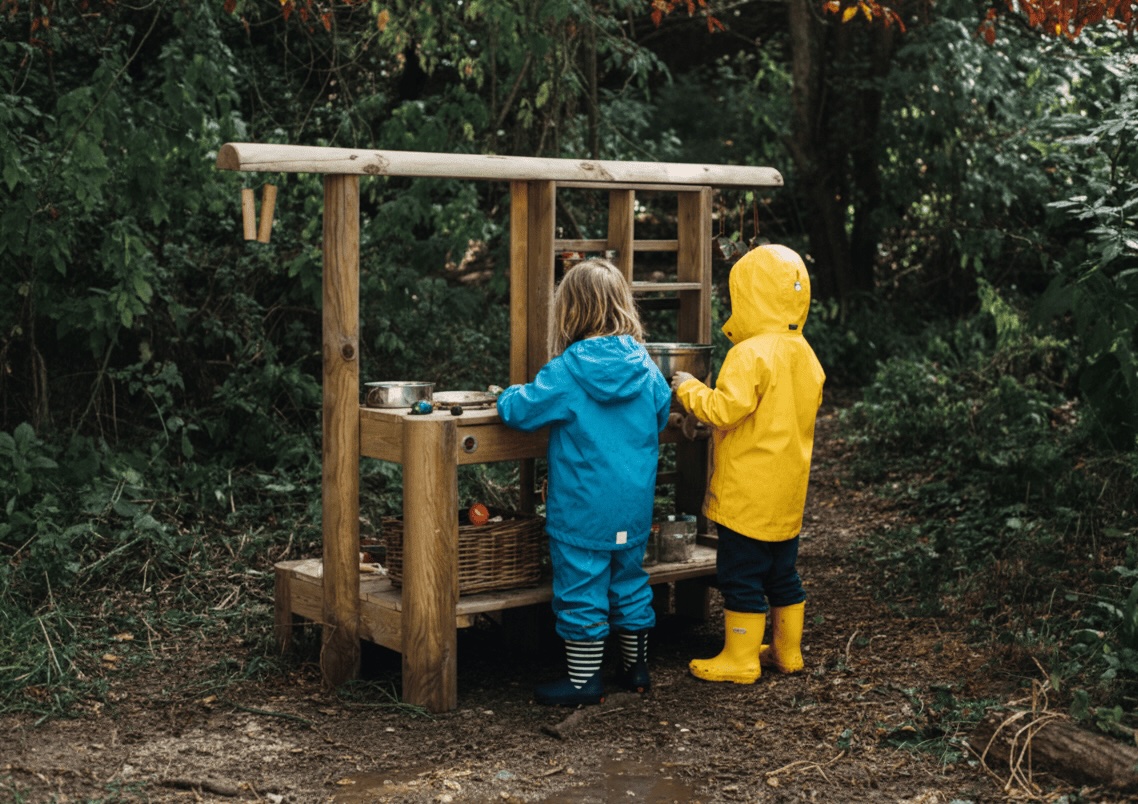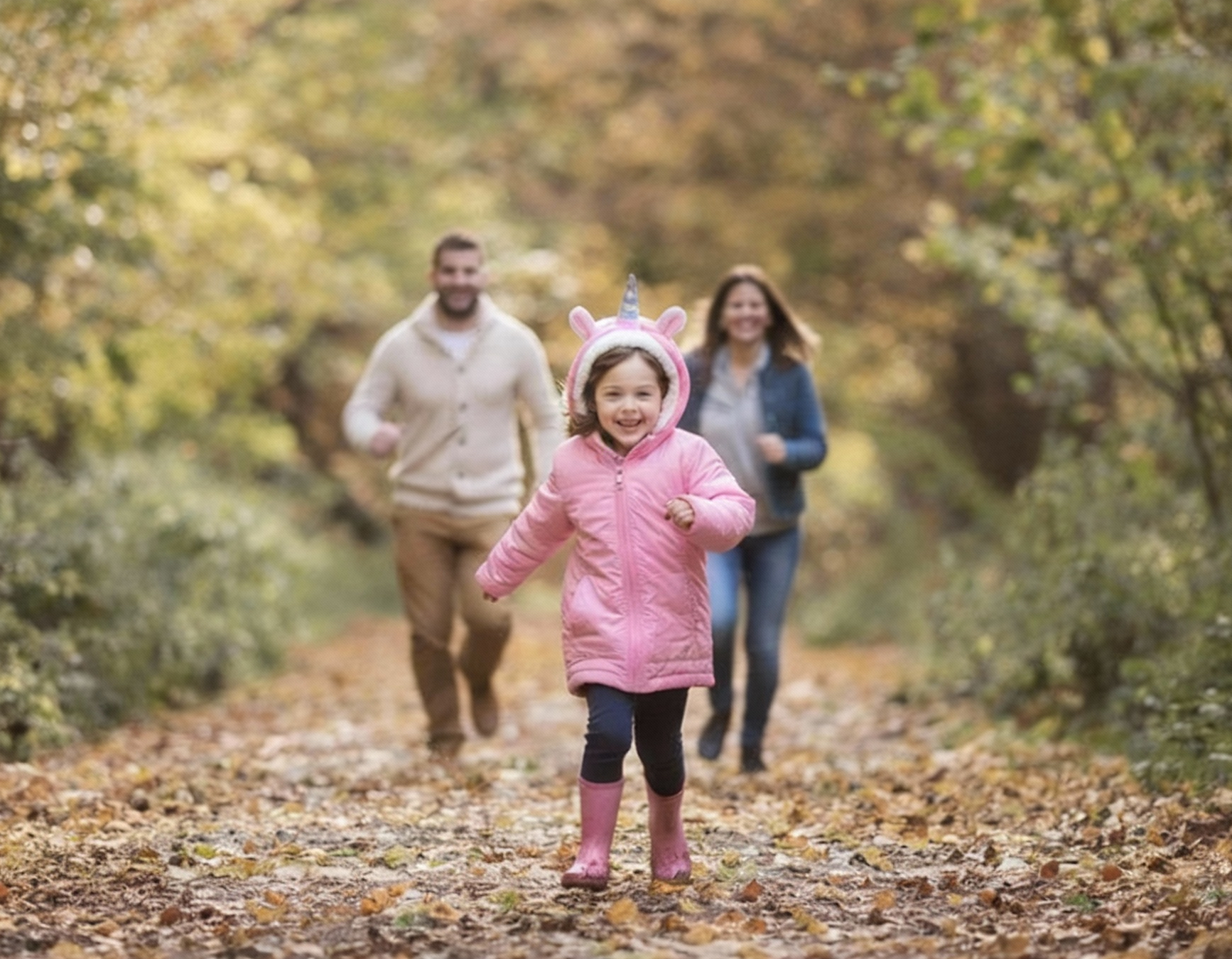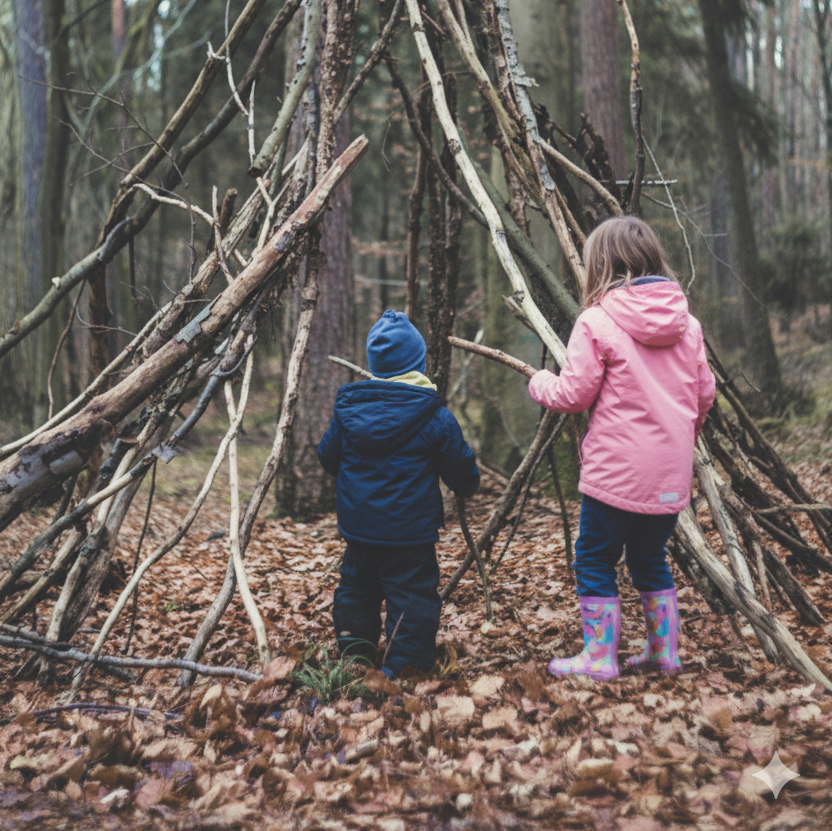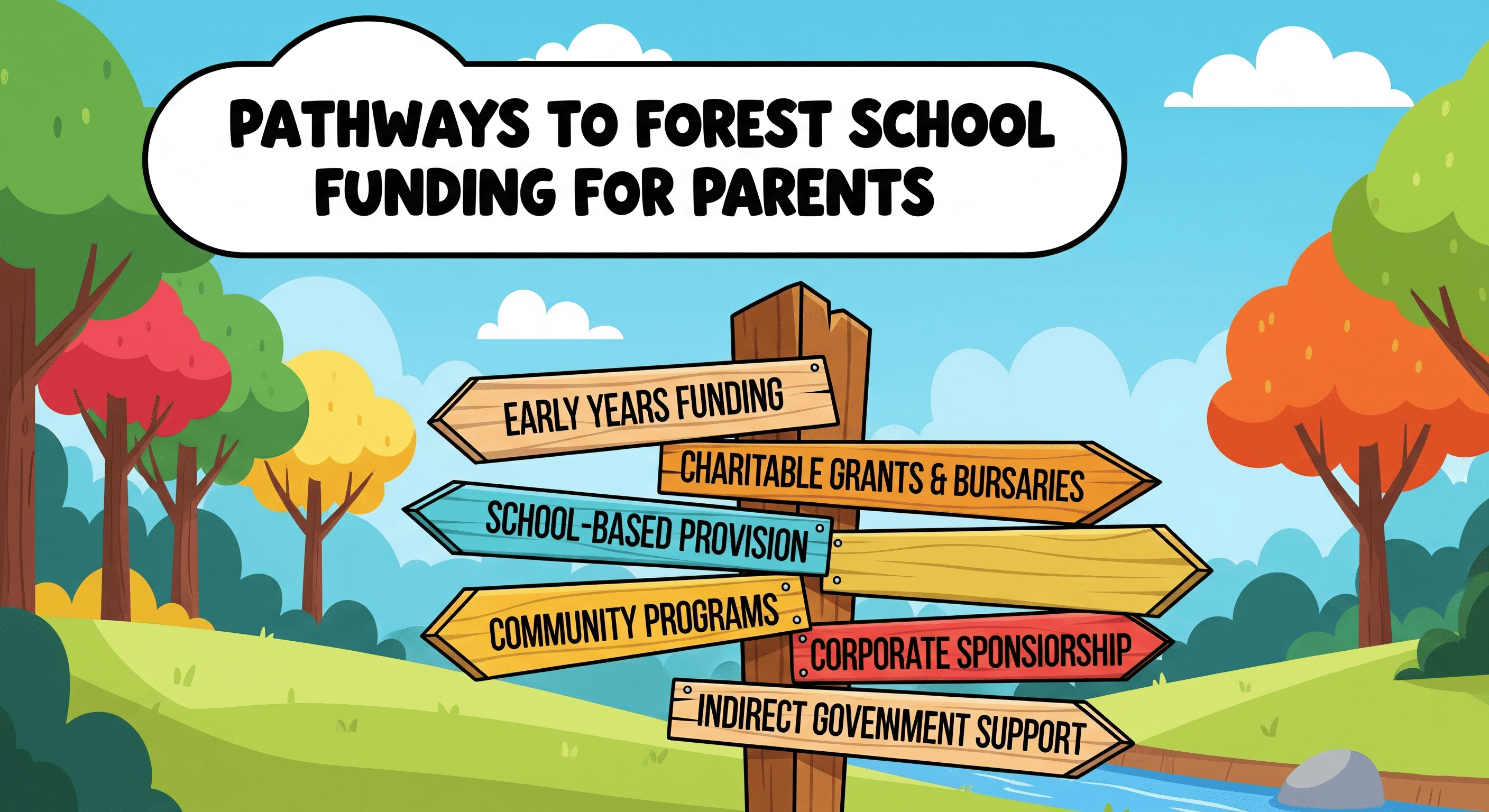· Education · 7 min read
Forest School on Rainy Autumn Days: What Parents Need to Know
Worried about Forest School on rainy autumn days? Discover why wet weather benefits child development, plus essential clothing tips and how to manage expectations as a parent.
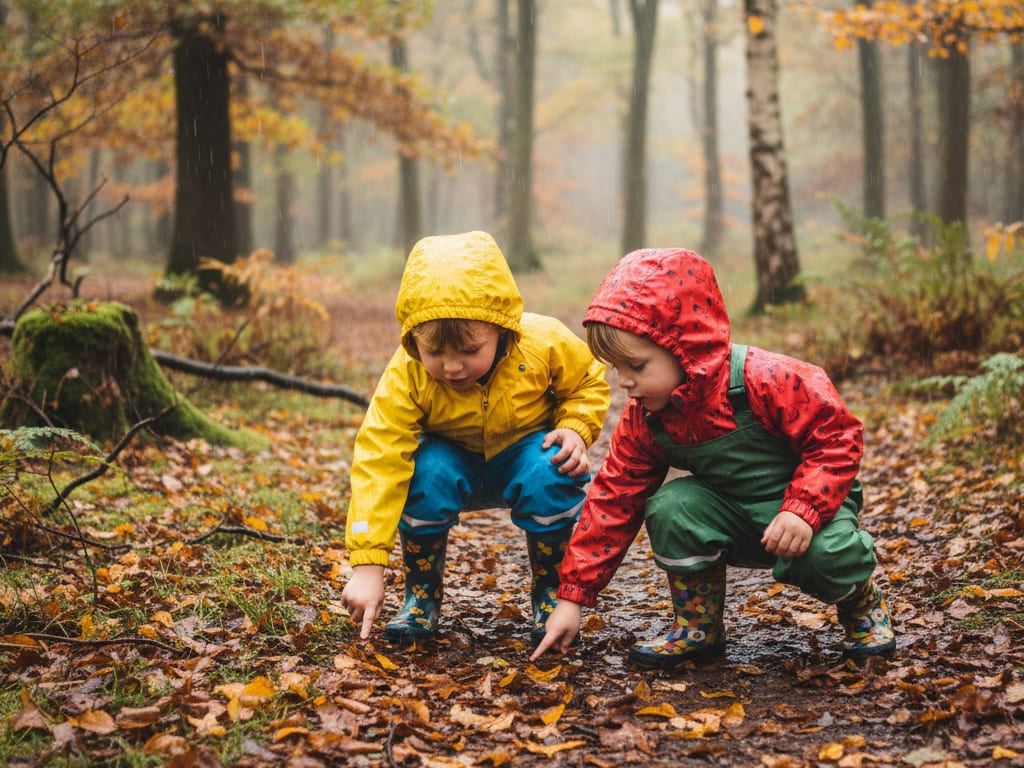
You check the weather forecast. Rain all day. Your child’s Forest School session is tomorrow. Should you be worried?
This concern keeps many parents awake the night before their child’s outdoor learning session. But here’s what most don’t realise: rainy autumn days at Forest School aren’t something to worry about. They’re some of the most valuable sessions your child will experience.
Let’s look at what really happens when it rains, why your child benefits from wet weather play, and how to prepare them properly.
What Actually Happens at Forest School When It Rains
Forest School sessions continue in the rain. Most programmes run outdoors in all weather, with no indoor space to escape to. The simple answer is that everyone gets a bit wet and muddy.
But Forest School leaders come prepared. They set up shelters where children can eat lunch or do crafts in a dry spot. Campfires become focal points for warming up. Hot chocolate and toasted marshmallows work wonders for chilly fingers. When children need extra warmth, leaders keep them moving with active games.
The rain itself becomes part of the adventure. Small streams appear, perfect for building dams or floating sticks. Slopes get slick, turning into natural slides. Mud pies and muddy faces become the stars of games.
Forest Schools do cancel sessions for severe weather. High winds over 32mph pose risks from falling branches. Lightning storms require immediate shelter. Heavy torrential rain that penetrates even the best waterproofs will stop a session. But normal British rain? That’s just part of the experience.
Why Rain Benefits Your Child
Rainy days offer unique developmental opportunities that sunny weather simply can’t provide.
Physical Development Gets a Boost
Slippery conditions require children to work harder on balance, improving coordination and gross motor skills. They need to think about where to stand, whether the climbing frame is too slippery today, and how to navigate muddy ground. This critical thinking about risk helps them manage their own safety.
Sensory Experiences Expand
Rain provides a complete sensory experience:
- Children hear the pitter patter on leaves and shelters
- They watch tarmac turn deep black when wet
- They feel damp, slippery surfaces
- They smell the fresh, earthy scent of rain
These different sensory inputs strengthen neural pathways in the brain.
Natural Learning Happens
Children learn how soil changes consistency after rain, becoming muddy and moldable. They see which trees provide better shelter. They discover that slugs, snails and worms emerge when it’s wet. These direct experiences teach scientific concepts far better than any indoor lesson.
Health Benefits Surprise Many Parents
Here’s what many don’t know: cold, wet weather doesn’t cause illness. Viruses spread in poorly ventilated indoor spaces. By taking children outdoors, they get fresh air and vitamin D, especially important during darker autumn months. Playing in rain promotes healthy lifestyles by teaching that weather shouldn’t prevent daily exercise.
Resilience and Confidence Build
Research shows positive impacts on children’s confidence, social skills, communication and motivation through Forest School. Rainy days add another layer. Children who learn to enjoy themselves in challenging conditions develop adaptability they’ll use throughout life.
The Clothing Question: Getting It Right
Proper clothing makes the difference between a miserable, cold child and one having the time of their life. The Forest School Finder Clothing Advisor takes the guesswork out of preparation.
Let’s walk through what your child actually needs for rainy autumn days.
| Layer | What to Choose | Why It Matters |
|---|---|---|
| Base Layer | Synthetic or wool top and leggings | Wicks moisture away, avoids clamminess of wet cotton |
| Mid Layer | Fleece jumper or lightweight insulated jacket | Provides warmth without bulk, unnecessary above 15°C |
| Outer Layer | Waterproof jacket and trousers (10,000mm rating) | Withstands heavy rain, not just showerproof |
| Footwear | Wellies with good grip plus wool socks | Wool provides insulation even when damp, cotton soaks like a towel |
Common Mistakes to Avoid:
- Dressing children in denim (heavy when wet, slow to dry)
- Relying on cotton layers (absorb moisture, leave children clammy)
- Skipping the spare clothes bag (even best waterproofs leak at joints)
- Tucking waterproof trousers into boots (water runs down and pools inside, soak the socks)
Budget-Friendly Options
Quality waterproofs cost money. But charity shops often have excellent outdoor clothing. Some schools keep spare waterproofs for families who need them. Supermarkets like Aldi and Lidl stock affordable outdoor gear seasonally.
What “Waterproof” Really Means
Look for waterproof ratings of 10,000mm with fully taped seams. This ensures clothing can withstand heavy, persistent rain. Showerproof jackets might handle light drizzle but fail in proper autumn downpours.
Puddle suits work brilliantly for younger children. For older children, separates allow flexibility. If the sun comes out, they can remove the jacket but keep waterproof trousers on for puddle jumping.
Managing Your Expectations (and Theirs)
Let’s be honest about what rainy Forest School days look like.
Your child will come home muddy. Properly muddy. Mud in their hair, under their nails, on their face. This is normal. This is good. Many adults find that watching their children play in all weather brings back memories of their own outdoor adventures.
Practical Tips for Parents:
- Car seat protection: Keep a bin liner or old towel in your boot. Lay it on the seat before your muddy child gets in
- Spare clothes bag: Pack extra jumpers, socks and trousers. Double up if toilet training
- Positive framing: Talk about puddle jumping, stream building and mud play before sessions
- Don’t force enthusiasm: Let children discover the joy themselves
Recognising Genuine Cold vs. Mild Discomfort
Children will feel the cold occasionally. That’s different from being dangerously cold. Forest School leaders monitor children carefully. They check for children who haven’t dressed properly or who refuse coats. If warming tactics like hot drinks, running games and fire warmth don’t work, they’ll contact you.
But a child saying “my hands are cold” while happily playing? That’s normal autumn weather. It’s not harmful.
Using the Forest School Finder Clothing Advisor
The Forest School Finder Clothing Advisor removes the guesswork from preparation. Here’s how it works.
Select your season from the dropdown menu. Choose “Autumn” for now. Then select the current weather condition. For rainy days, choose “Wet.”
The tool immediately shows specific recommendations for autumn wet weather. It focuses on staying dry during autumn rains while maintaining warmth. You’ll see exactly what base layers, footwear and outer layers your child needs.
The recommendations account for British weather realities. They understand that autumn rain differs from summer showers. The clothing needed for a damp October morning isn’t the same as a mild September drizzle.
The tool saves you from over-preparing or under-preparing. You don’t need to guess whether your child needs thermals or just a fleece. The advisor tells you based on the actual conditions.
Before each Forest School session, spend two minutes with the Clothing Advisor. Check the weather forecast, input the conditions, and dress your child accordingly. It’s that simple.
Rain at Forest School Is Not Just Manageable, It’s Valuable
Rainy autumn days at Forest School offer developmental benefits that dry weather can’t match. Children develop physical skills faster in rain due to challenging conditions. They gain sensory experiences unique to wet weather. They learn scientific concepts through direct observation.
The key is proper preparation. Use the Forest School Finder Clothing Advisor to dress your child correctly. Pack spare clothes. Accept that mud happens. Trust the Forest School leaders to keep your child safe and engaged.
Research consistently shows that Forest School experiences build confidence, resilience and a connection to nature. Rainy days amplify these benefits by teaching children that weather doesn’t stop adventure.
Your child’s outdoor memories will be made in all weathers. The rainy days often become the ones they remember most fondly. The day they built a dam in the stream. The time they made the biggest mud pie ever. The afternoon they discovered how many worms come out when it rains.
So when you check that forecast and see rain, don’t worry. Just make sure they’re dressed properly, and let them go discover why puddles are so much more than just water on the ground.
